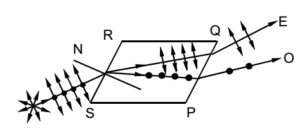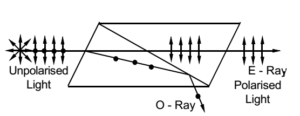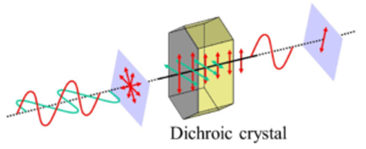Science > Physics > Wave Theory of Light > Polaroids
In this article, we shall study the use of the phenomenon of polarization of light, principle, construction, and working of polaroids.
Double Refraction:
In the case of some crystals like calcite or quartz, a single ray of unpolarized light from a point source of light splits up into two refracted rays casting two images of the point object. This phenomenon is known as double refraction or birefringence. In this case, both the refracted rays are polarized in two mutually perpendicular planes.

Nicol’s Prism:
The phenomenon of double refraction is used to get polarized light from Nicol prism. This was constructed by William Nicol in 1828 A.D. In this method ordinary rays are eliminated by total internal reflection and only extraordinary rays are allowed to come out of the prism.

Construction:
A naturally occurring form of calcium carbonate is known as Calcite or Iceland spar. In Nicol’s prism, the length of the crystal is three times the breadth. The ends are grounded until they make an angle of 68° and 112° to form a parallelogram. These crystals are cut into two halves and cemented together by means of Canada balsam. This gives Nicol prism. Nicol’s prism can be used as a polarizer as well as an analyzer.
Polaroids:
Polaroid is a large sheet of synthetic material packed with tiny crystals of a dichroic substance oriented parallel to one another so that it transmits light only in one direction of the electric vector.

Doubly refracting crystals split the incident unpolarized light passing through them into O – light, and E – light which are plane-polarized in mutually perpendicular planes. Some such crystals have the property of absorbing the ordinary and extraordinary light unequally. This property is called dichroism and crystal possessing this property is called dichroic. e.g. tourmaline. It absorbs O – light and transmits E – light.
Polaroids are artificially prepared dichroic substances. In 1852, W. H. Herapath discovered synthetic crystalline material iodosulphate of quinine known as herapathite which exhibits dichroism. In 1934 E.H. Land embedded tiny herapathite crystals in cellulose acetate with their optic axis parallel. The layers of the crystal were mounted between two glass sheets for protection. This acts as a sheet of the polarizer and called as polaroids. It can be used as a polarizer as well as an analyzer.
Uses of Polaroids:
- Light usually scatters in all directions; but when it’s reflected from flat surfaces, it tends to become polarized. This creates an annoying and sometimes dangerous intensity of reflected light that causes glare and reduces visibility. Polaroids are used in sunglasses to cut off the glare reflected by horizontal surfaces.
- Polaroids are used in glass windows of an airplane to control the intensity of light entering the airplane.
- Polaroid glasses are used to view three-dimensional pictures and movies.
- Polaroids are used as a filter in the photographic camera.
- They are used in the production and analysis of plane-polarized light.
- They are used to improve colour contrast in old oil paintings.
- They are used in calculators, watches, monitors of laptops which have LCD screens.
Doppler Effect in Light:
The apparent change in the frequency of the light observed by an observer, due to relative motion between the source of the light and the observer, is called the Doppler effect.
One major difference between Doppler Effect exhibited by sound and light is as follows: In the case of sound, the frequency change depends on whether the source is moving or the observer is moving even if their relative velocities are the same. In the case of light, the Doppler Effect depends only on the relative velocity of the source and the observer, irrespective of which of the two is moving. Hence the Doppler effect exhibited by light is symmetric.
Red Shift of Light:
When the source and observer move away from each other, the wavelength in the middle of the spectrum will be shifted towards red. This phenomenon is called a red shift due to Doppler effect. When the source and observer move away from each other, the observer observes the lower frequency than the actual frequency of the light (towards red).
Blue Shift of Light:
When the source and observer move towards each other, the wavelength in the middle of the spectrum will be shifted towards blue. This phenomenon is called a blue shift due to the Doppler Effect. When the source and observer move towards each other, the observer observes the higher frequency than the actual frequency of the light (towards blue).
Applications of Doppler Effect in Light:
- It is used to measure the speed of rotation of the sun.
- It is also used in the measurement of plasma temperature.
- Edwin Hubble (1889-1953) found a method to red shift and blue shift to study the relative motion of the stars and galaxies.
- It is used in tracking satellites.
- They are used in speed guns to measure speed of cricket and tennis ball.
Use of Doppler Effect of Light to Measure Speed of Rotation of the Sun:
A spectrum is an arrangement of electromagnetic radiation, which includes visible light, placed in order of wavelength. The spectrum of light tells us about the composition of an object such as a star, its temperature, its pressure, the abundance of elements in the star, its motion (velocity), etc.
We observe the spectrum from different regions. If the lines are shifted towards the red end (longer wavelengths) relative to a spectrum at rest than that part of the Sun is moving away from us; a blue shift tells us that region of the Sun is approaching us. The extent of the shift tells us the velocity.
The east and west edges of the sun are photographed. Each photograph contains absorption lines due to elements like vapourized ion in the sun and oxygen in the earth’s atmosphere. Then the two photographs are put together such that the oxygen lines coincide. We observe a relative displacement in the iron lines w.r.t. each other. One line corresponds to the edge of the sun approaches the earth while another line corresponds to the other edge of the sun that recedes from the earth.
The difference in spectral lines is used to measure the speed of rotation of the sun. It is nearly 2 km/s.
Use of Doppler Effect of Light to Measure Plasma Temperature:
Plasma is phase constituting very hot gases where the temperature is of the order of millions of degrees Celsius. Plasma state is obtained in thermonuclear fusion experiments. In this state, the gas molecules are moving towards or away from the observer at very high speeds. Due to the Doppler Effect, the wavelength observed of a particular spectral line is different from the actual wavelength.
One edge of the line corresponds to an apparently increased wavelength due to the molecules directly moving towards the observer while the other edge of the line corresponds to an apparently decreased wavelength due to the molecules directly moving away from the observer. The line is thus observed to be broadened. A diffraction grating is used to measure the breadth of the line. As we know the wavelength λ and speed of light v, the temperature of the gas can be obtained using the formula

Where R is the molar gas constant, T is the temperature of the gas, M is the molecular mass of the gas.
Previous Topic: Polarization of Light
For More Topics in Physics Click Here
